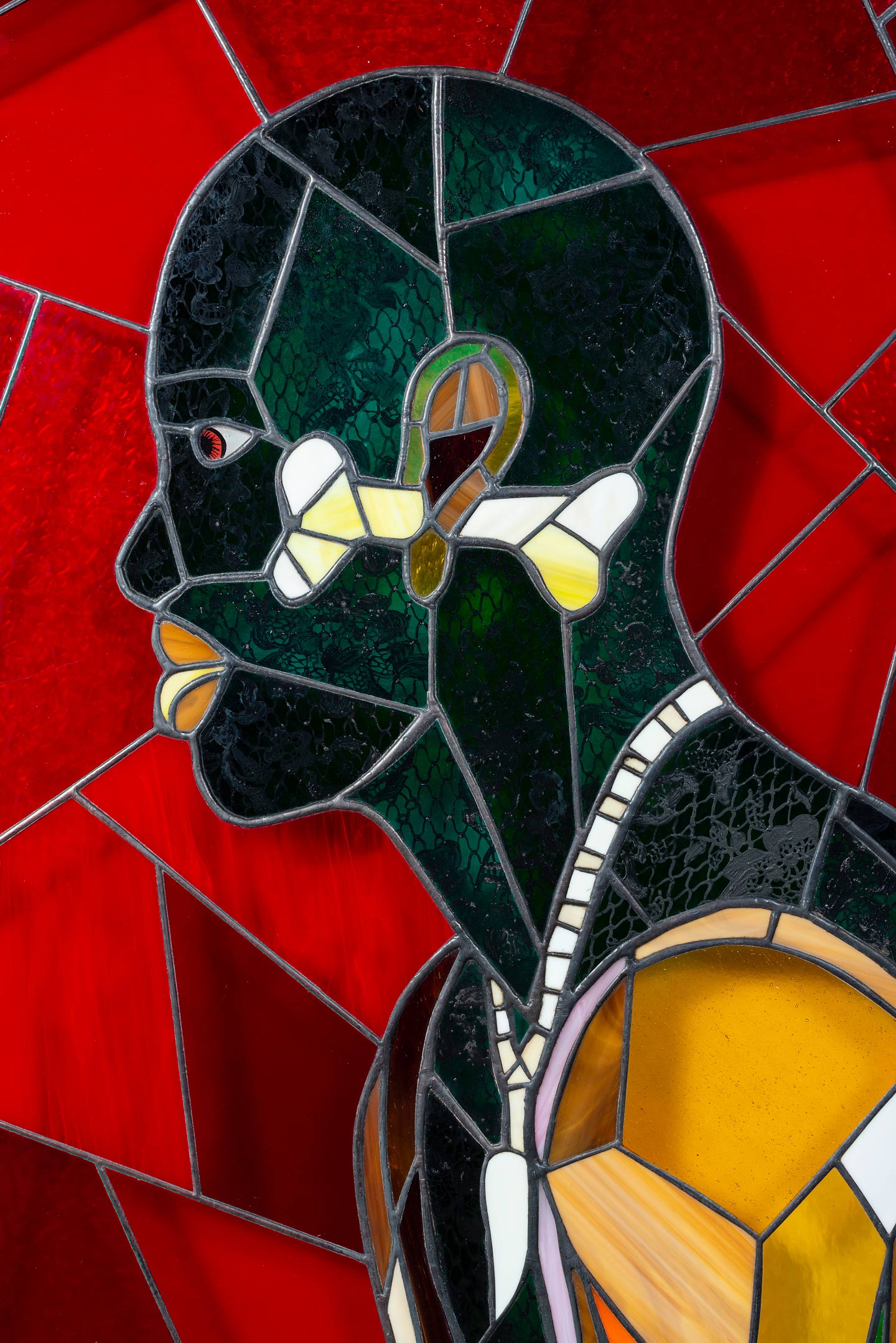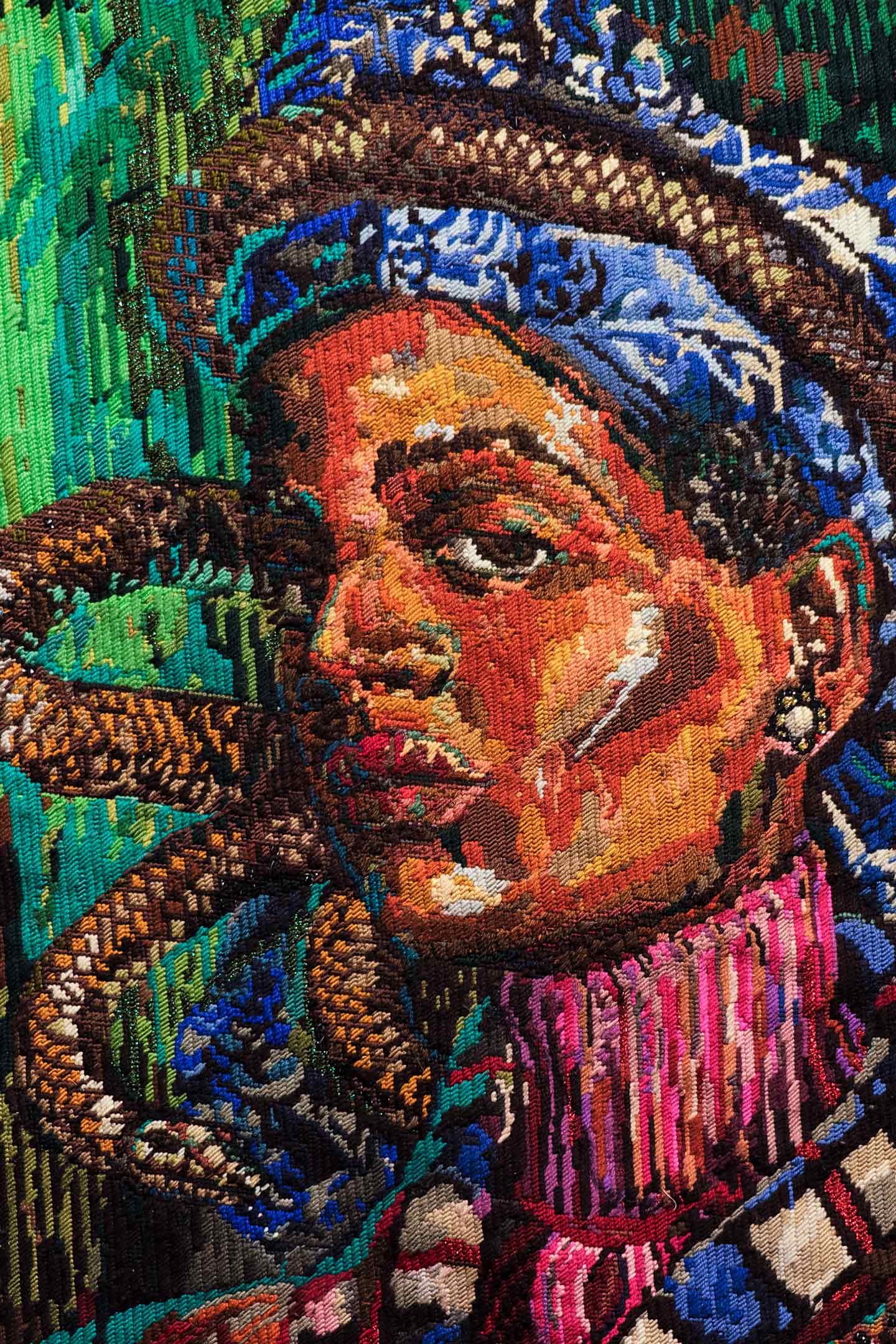We are often told that stories should have beginnings, midpoints and endings. And that they are logical and can be arranged sequentially. Furthermore, a hierarchy is often placed on which stories (about whom, for whom and by who) matter —these hierarchies valorise narratives held dear by the dominant cultures, while stripping dignity away from those who are considered other. Imagine the sense of loss and dissonance that one can feel when one’s reality is removed from the stories that one sees validated, endorsed, “approved”. Stories have the potential to emancipate or at least to begin the long, difficult and painful process of emancipation. And so it is important for us to continue to tell our own stories, steeped in created universes filled with fantasies, beliefs, superstitions and dreamworlds alike.
Athi-Patra Ruga is an artist whose work adopts myth and mythmaking as a contemporary response to the post-apartheid era. Ruga creates alternative identities and uses these avatars as a way to parody and critique the existing political and social status quo. Ruga’s artistic approach of creating myths and alternate realities is in some way an attempt to view the traumas of the last 200 years of colonial history from a place of detachment – at a farsighted distance where wounds can be contemplated outside of personalised grief and subjective defensiveness (excerpt from artist bio). Ruga’s latest offering is a saga in two parts; Interior/Exterior ⁄ Dramatis Personae. I reached out to Ruga to chat about this project.

Yellow Bone (detail)
Can we begin with the title of this work; Interior/Exterior / Dramatis Personae. What do each of these allude to and how are they related/unrelated?
The studio decided to present a saga that will exist as an exhibit in continuum and is split into two parts. The first being Interior/Exterior – where I am continuing my apprenticeship as a stain glass maker which first was exhibited in 2013. The body as it stands now is a series of five windows that depict our established avatars from my 15-year tapestry practice. They have been a saga in continuum and have been exhibited at Somerset House and The Hayward Gallery and finally will be hung in situ at the WHATIFTHEWORLD gallery in Cape Town. It is these glazed characters that have swept the way for a new set of avatars that I am introducing with Dramatis Personae. The story world is still Azania and we navigate the tale of Nomalizo Khwezi.
I’m thinking about whether an interior and an exterior necessitate a centre (if not they at least suggest a periphery or an edge, I think). What is at the centre/edge of the narratives you are presenting to those engaging with your work?
At the core of it the idea of human dignity and facilitating it by centralising my community which is deliberate in its black/queer/femme-ness. In Interior/Exterior we use glass which is a medium that requires a community, and by nature embedded with storytelling modes. Enter Nomalizo Khwezi who’s performance is that of an outsider coming in with the big lie of wanting to change systems from the inside out.
The materials used (both the stained glass and wool & thread) are loaded and carry with them specific associations and histories. I’m interested in what your personal relationship is to these materials? What do they allow the work to do?
I’d like to continue on your last point with this. Interior/Exterior is manifested by the phenomenon of solar energy going through a prismatic glass that depicts images traditionally in the realm of religious/ nationalist or moral tales that offer a sense of belonging to or an aspiration from the congregation. Being raised in a rich environment that practised both isiko and Anglicanism I have always had that tension of being in or out. Something I think I share with my audience. My avatars serve to upend the prestige and staid use of the material. Therefore beatifying(sic) them and bringing them into the populace that experiences the solar/image phenomenon. The final push to continue, then happens at our family church in Gompo, East London, where I attended mass some years ago and saw this beautiful stained glass dedication to Mam Archdeacon Mfenyana— this monument to a local hero depicted the annunciation (with Gabriel and Maria) with Black people….the church insisted on that. Thereby, the act of art does play a role in giving dignity to a community that has been on the outside of the story.

Nobantu and Umjola (after AC Jordan, 1940) (from the Lunar Songbook) (detail)
Your work is not necessarily about religion but the imagery evokes religious undertones (with the stained glass and the music accompanying some of the videos), I’m wondering about this decision to use types of imagery that might be linked to these notions.
For as long as I’ve been cognisant I have always looked at the product and circumstances of divine expression through all cultures and religions. So it’s in me and I like how counter-modern it is … the (re) sublimation of art in contemporary times.
I’m a gospel hearer and from the beginning of my practice that has been the tool I use to access the resistance and spirit of my community.
I’m going to give you a few phrases and I’d like you to tell me what they bring to mind in relation to your practice:
a) Church bells
A signal for one to take a scene stance for a divine process whether its art-making or civil resistance. Studio praxis for us is like praying.
b) God
In whatever shape they take when they have been put through the human imagination.
c) Utopia
… as the sun highlights the lack in all of us. I feel Utopia only serves as a way of reflecting on how we could be better, how we could tell better story worlds.
d) Azania
A bittersweet space that has empowered me to bend time and subvert staid narratives on what freedom is for me and my community.
Can you tell us a bit about the two characters: Nomalizo Kwezi and Nobantu? What are their stories? What do they want?
Lol. I know that the textbook definition of a character is that which they want. But I will neglect that by telling you who they are. Nomalizo Khwezi (named after a Letta Mbulu song and the Morning Star iKhwezi) is a child prodigy who was extricated from her home in Ndema, Tsomo at age thirteen after she designed a poster for the Azanian Banks conscription campaign. She would grow up in a prestigious boarding school under the patronage of Memnus Brink, the owner of Brink Publishing Pty Ltd in Azania City. Upon getting her promotion to her job as head of textbooks and propaganda, she learns that Memnus has been involved in some shady deals that implicate her in a national textbooks crisis. She meets Nestra and begins an affair after they meet in a club floor. They bond over their relationship with their respective boy children Oratile and Mayibuye. Anyway, in the end, the body count is at three men …somewhat under the complicity of these two womxn.



















































